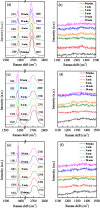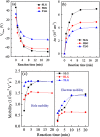Improving the electrical properties of graphene layers by chemical doping
- PMID: 27877716
- PMCID: PMC5099677
- DOI: 10.1088/1468-6996/15/5/055004
Improving the electrical properties of graphene layers by chemical doping
Abstract
Although the electronic properties of graphene layers can be modulated by various doping techniques, most of doping methods cost degradation of structural uniqueness or electrical mobility. It is matter of huge concern to develop a technique to improve the electrical properties of graphene while sustaining its superior properties. Here, we report the modification of electrical properties of single- bi- and trilayer graphene by chemical reaction with potassium nitrate (KNO3) solution. Raman spectroscopy and electrical transport measurements showed the n-doping effect of graphene by KNO3. The effect was most dominant in single layer graphene, and the mobility of single layer graphene was improved by the factor of more than 3. The chemical doping by using KNO3 provides a facile approach to improve the electrical properties of graphene layers sustaining their unique characteristics.
Keywords: Raman spectroscopy; chemical doping; electrical properties; graphene; potassium nitrate.
Figures





References
LinkOut - more resources
Full Text Sources
Other Literature Sources
